Today, the Communist Party of the People's Republic of China controls the world's second most powerful navy. A quarter-century ago, it was essentially a coastal-defense force, focused on keeping China's maritime frontiers safe from outside interference. Today, it is a true blue-water force with global capabilities, and it continues to develop into a true rival for the US Navy. This progress has been the deliberate result of strategic choices to emphasize Chinese maritime power in the face of increasing reliance on the oceans for trade and resources, as well as concern about Taiwan and the threat of US naval power. Now, it is focused on operations past the "first island chain", stretching from Japan to Taiwan, the Philippines and Indonesia.
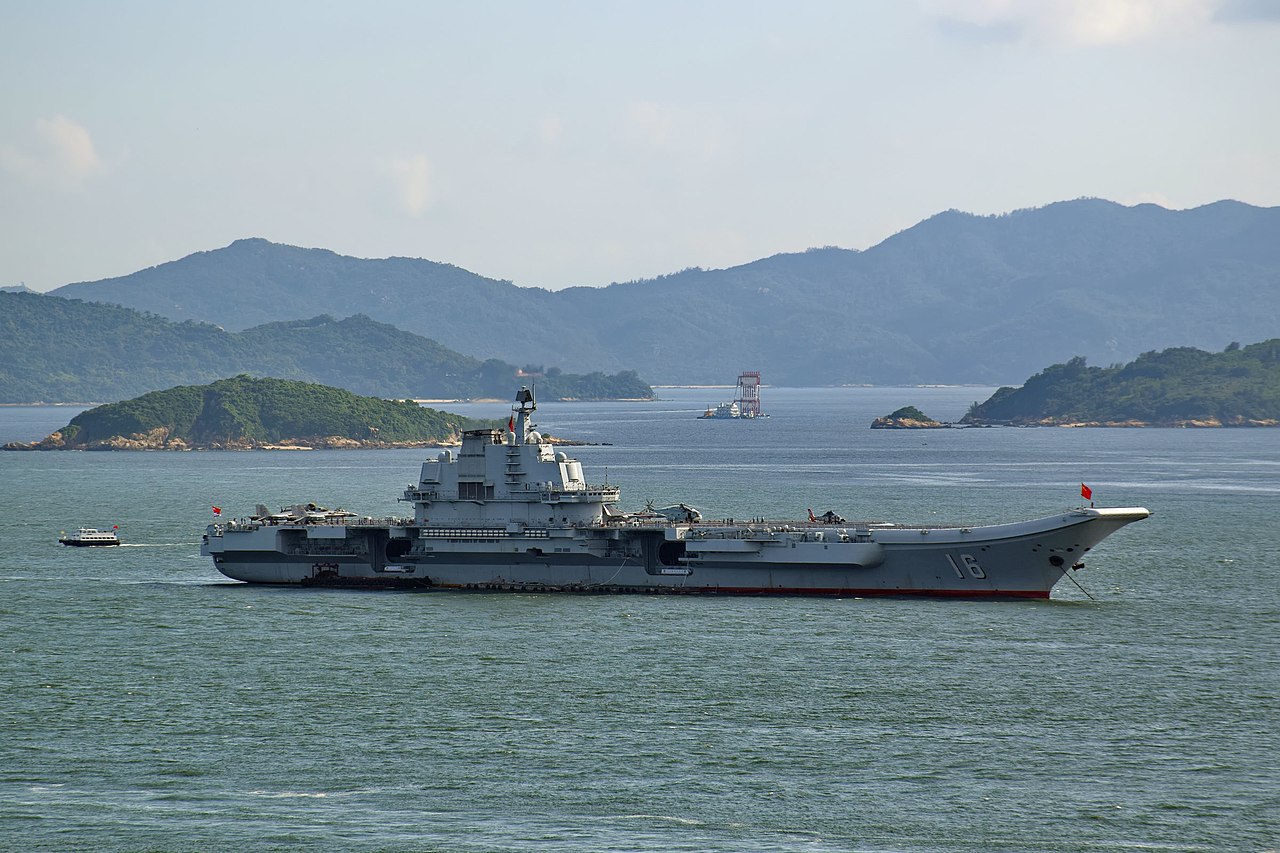
Liaoning, symbol of China's new naval power
Serious operations past the first island chain began in the mid-90s, when the People's Liberation Army Navy began annual visits to other countries, including a 1997 cruise to Hawaii, San Diego, and Latin America. Over the next decade, the tempo of deployments increased, and Chinese ships showed the flag on every continent except Antarctica. But the real sea change took place in 2008, when China joined the UN-sponsored antipiracy patrols off Somalia. Since then, they have kept two surface combatants and a replenishment ship continually deployed, and the mission has served as a crash course in the lessons necessary to operate as a true blue-water navy. Issues faced and overcome ranged from logistics and personnel issues to communications and command structures to the heat and sand of the Gulf of Aden. Today, these deployments usually involve about 4 months of antipiracy duties,1 followed by two months of port visits and exercises with other navies.
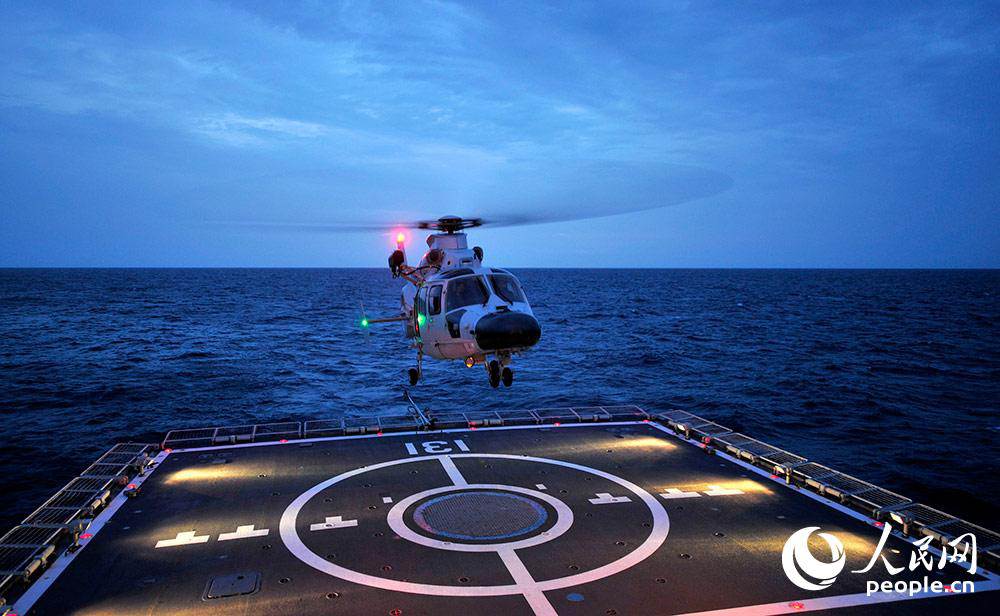
The PLAN operates helicopters in the Gulf of Aden
The commitment to anti-piracy work has been indicative of the increasing Chinese concern about their Sea Lines of Communication (SLOCs), which supply them with vital resources, most notably oil from the Middle East, and carry their exports to markets worldwide. Keeping them open in a conflict is one of the PLAN's announced missions, and they are taking it seriously despite the threat posed by the USN. Worldwide deployments have also proved valuable in protecting the hundreds of thousands of Chinese citizens in Africa and the Middle East, running evacuations from Libya in 2011 and Yemen in 2015. These are the traditional missions of the navies of the great maritime powers, most notably the USN and RN, and the PLAN has joined their ranks over the last decade.
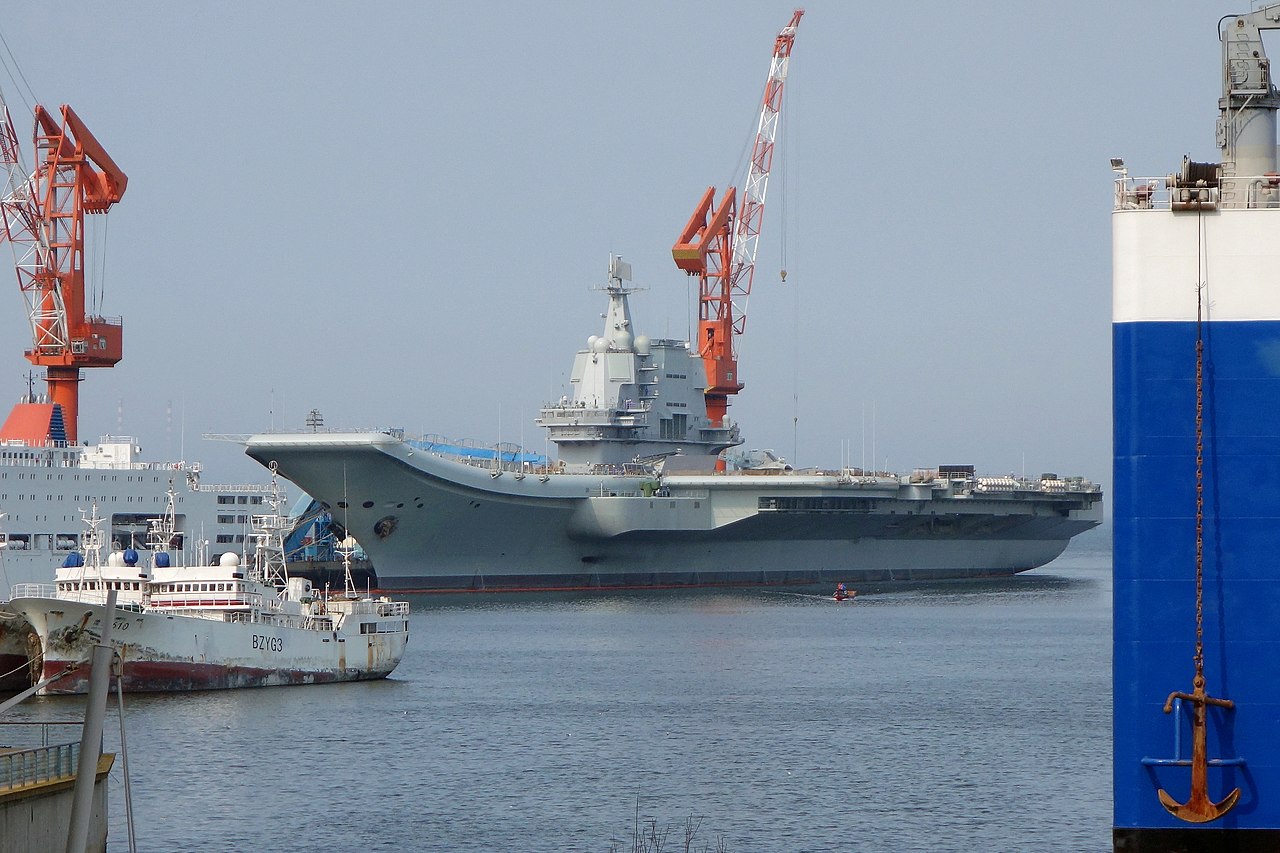
Shangdong
The most notable sign of this has been the development of the PLAN's aircraft carrier force. Currently, they have two carriers in service, Liaoning and Shangdong, both based on the Russian Admiral Kuznetzov design. Liaoning was laid down in Ukraine in 1985 but never completed. The rusting hulk was bought in 1998 by a Chinese corporation claiming that they planned to turn it into a hotel and theme park, although plans to tow it to China turned into a debacle when Turkey denied it permission to pass through the Bosphorus, and the tugboat spent 16 months circling the Black Sea before Turkey finally relented and allowed it to pass into the Mediterranean in 2001. The next decade was spent turning the hulk into a warship, and she commissioned in 2012, although she has been used primarily to learn the art of operating fixed-wing aircraft at sea, and is probably only marginally combat-capable. Shangdong was laid down three years later to a slightly stretched version of the same design, and commissioned in late 2019.
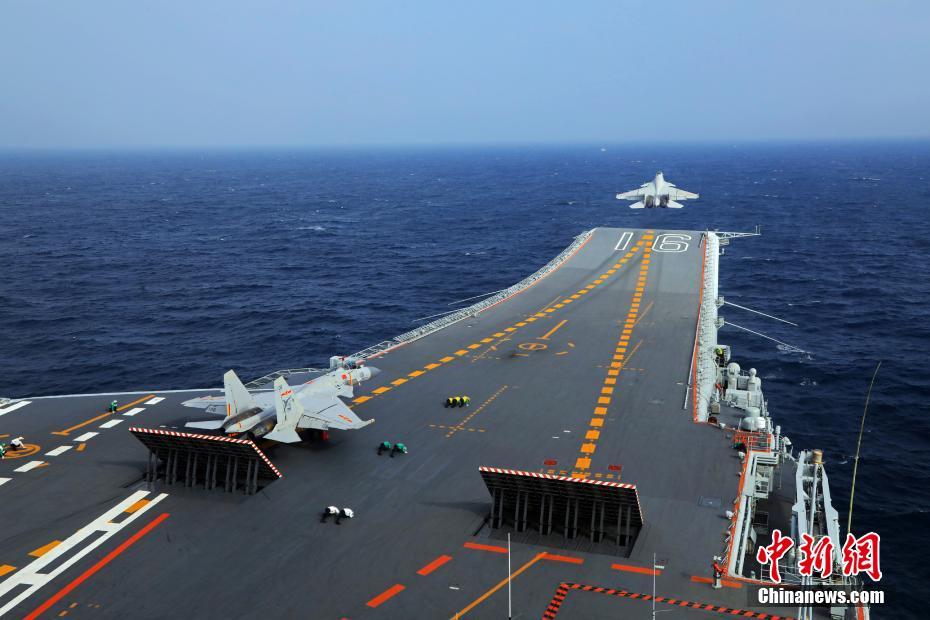
J-15s fly off Liaoning
Both of these ships are around 65,000 tons and use a ski-jump to launch their aircraft, which limits them to high-performance fighters (probably about 24 for Liaoning and 32 for Shangdong) and helicopters (12 or so each, a mix of ASW, AEW and utility). But their next carrier Fujian, is significantly larger, around 80,000 tons, and is fitted with electromagnetic catapults. She launched in June 2022, and is currently fitting out. Long-term plans appear to call for six carriers, although this may have been cut to four in the last year or two, with the last carrier, probably not yet laid down, to be a full nuclear-powered supercarrier along the lines of the Nimitz and Ford classes. Aircraft development is trailing slightly, with the mainstay of the force being the Shenyang J-15, a derivative of the Russian-designed Su-27 Flanker. It has not proven particularly effective, and the PLAN seems to be looking at a fifth-generation fighter, either the J-20 or FC-31, as a long-term solution.
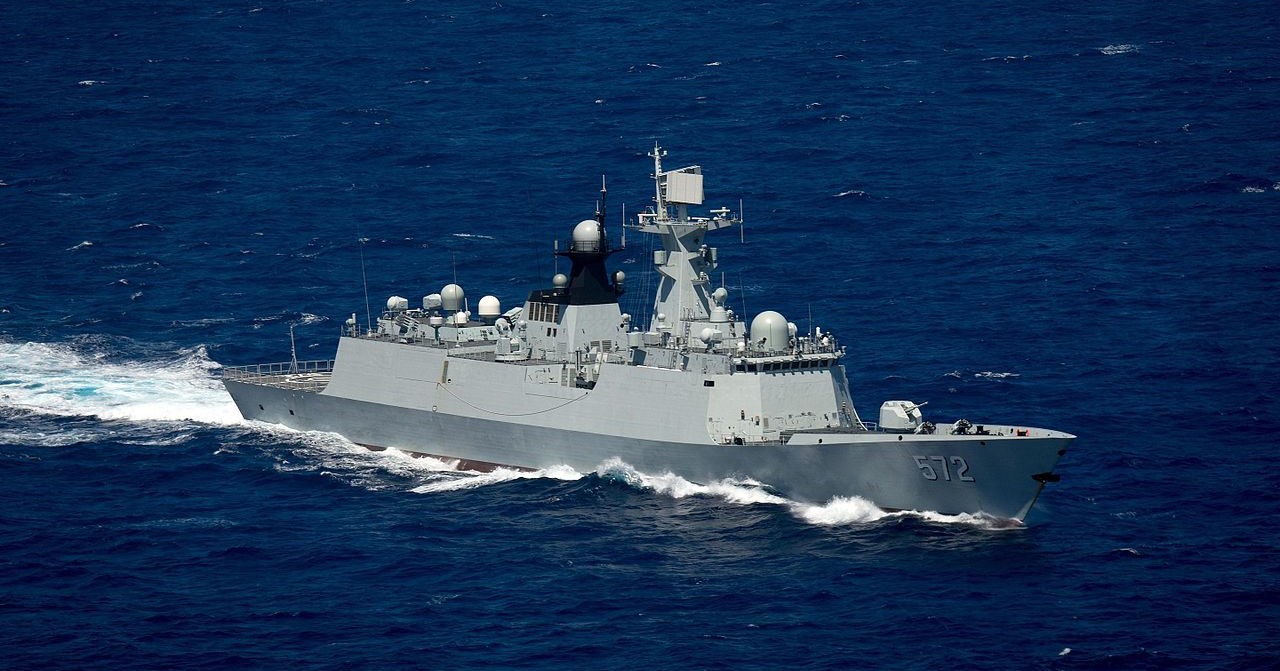
Hengshui, a Type 054A
But carriers also require escorts, and the Chinese have been producing these in great quantities. Before 2004, their surface combatant program was essentially an R&D project, building a handful of ships of each design and taking the lessons forward into the next one. But the last 15 years have seen Chinese shipyards churn out massive quantities of two basic designs, the Type 054A frigate and the Type 52D destroyer.2 The Type 54A is a fairly standard general-purpose frigate, displacing about 4,000 tons and armed with a 32-cell VLS carrying HQ-16 SAMs3 and the Chinese version of VLASROC, 8 YJ-83 anti-ship missiles,4 a 76mm gun and two Type 730 CIWS. Each has a comprehensive sonar suite, including hull-mounted sonar, a towed array and a variable-depth sonar,5 as well as a helicopter, either a Russian-designed Ka-28 or a Z-9C, a license-built version of the Eurocopter Dauphin. These frigates, 30 of which have been built for the PLAN, have served as the backbone of the anti-piracy deployments.
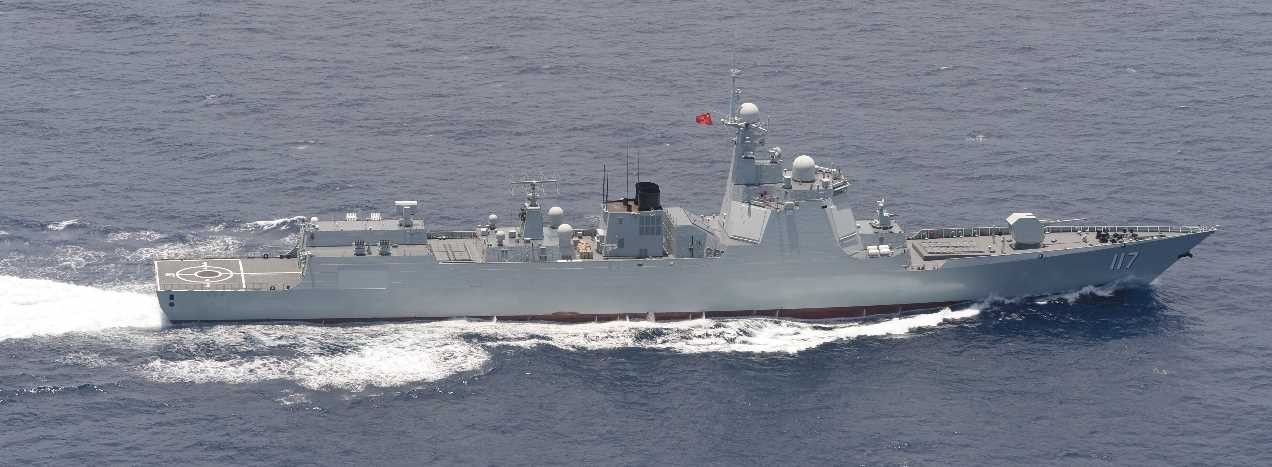
Type 052D Xining
The Type 52D is still being built, with 25 units in service and another 6 expected to enter service in the next few years. Each displaces around 7,500 tons, slightly less than a Burke and is equipped with the Chinese equivalent of Aegis, built around the Type 346 radar. Armament is a 64-cell VLS carrying HHQ-9 SAMs, YJ-18 ASMs, CJ-10 land-attack missiles and an anti-submarine missile, a 24-missile HQ-10 SAM launcher,6 a 130mm gun and CIWS. Besides the radar, the Type 052D is equipped with a similar sonar suite to the Type 054A, and it also carries a helicopter. Some later units of the class have an extended flight deck, probably to operate the Z-20 helicopter, a broad match for the American SH-60.
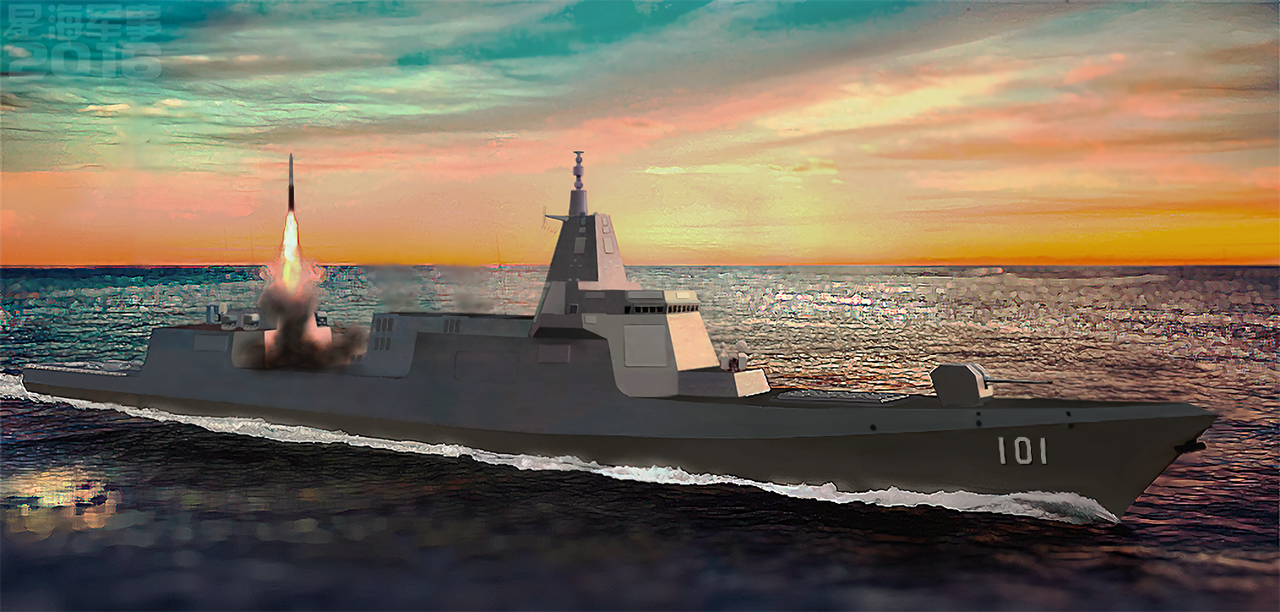
Artist's impression of a Type 055
But the Type 052D has one drawback: it has only 64 VLS cells, which must be split between four different roles. To fill this gap, the PLAN has introduced the Type 055 destroyer, a 13,000 ton vessel that the USN classifies as a cruiser due to its size and expected role as a command ship for anti-air warfare. Each Type 055 is equipped with 112 VLS cells, carrying the same weapons as the Type 052D, as well as two helicopters and a 130mm gun. Uniquely, the Type 055 has two phased array radars, the long-range S-band Type 346 it shares with its predecessor and a new X-band radar for tracking smaller, stealthier targets at short range. Eight are in service in early 2023, with as many as 16 ultimately planned.
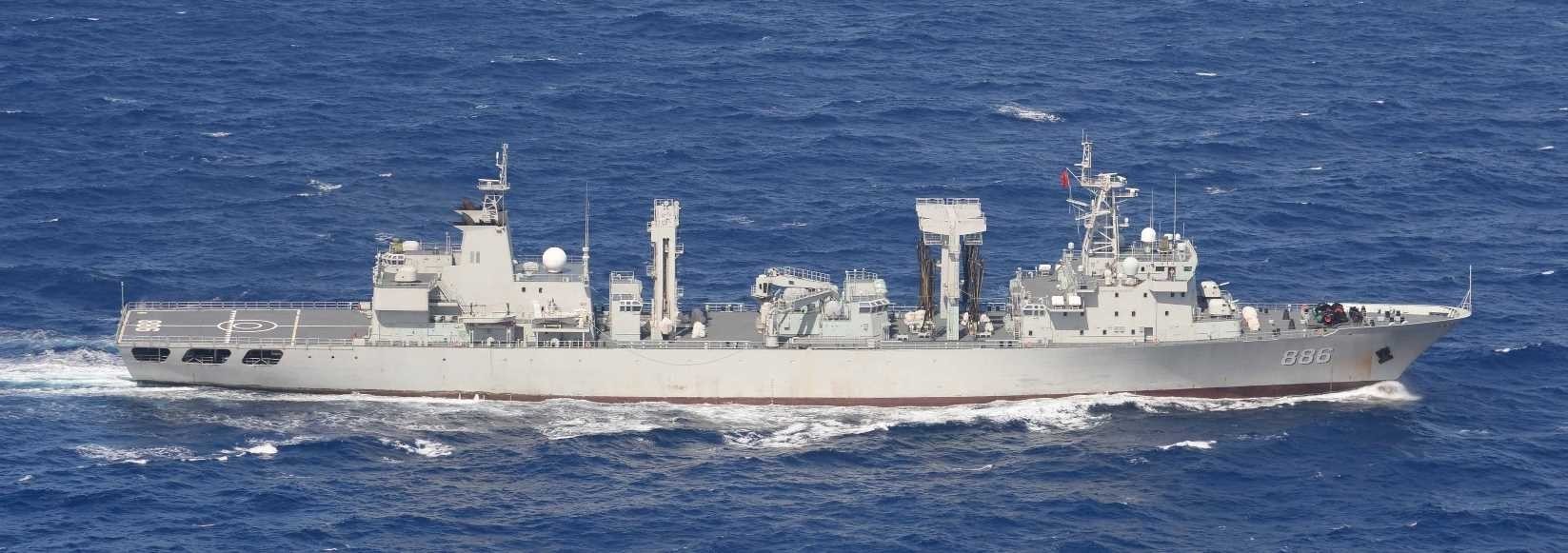
Qiandao Lake, a Type 903
Destroyers and frigates alone aren't really capable of worldwide operations, and China has been busy building up the less appreciated but still vital auxiliary force to support its blue-water capabilities. The backbone of this fleet is the Type 903 replenishment ship, a vessel that like most modern support ships is capable of transferring fuel and supplies at sea. Only two were built initially, and they were worked very hard supporting the antipiracy deployments, but 7 more have joined their number since 2013. The Type 903s are limited to 20 kts, and to support the carrier groups, two ships of the faster Type 901 design have been built. On the whole, this gives China a capability second only to the USN to sustain its fleet in distant waters.
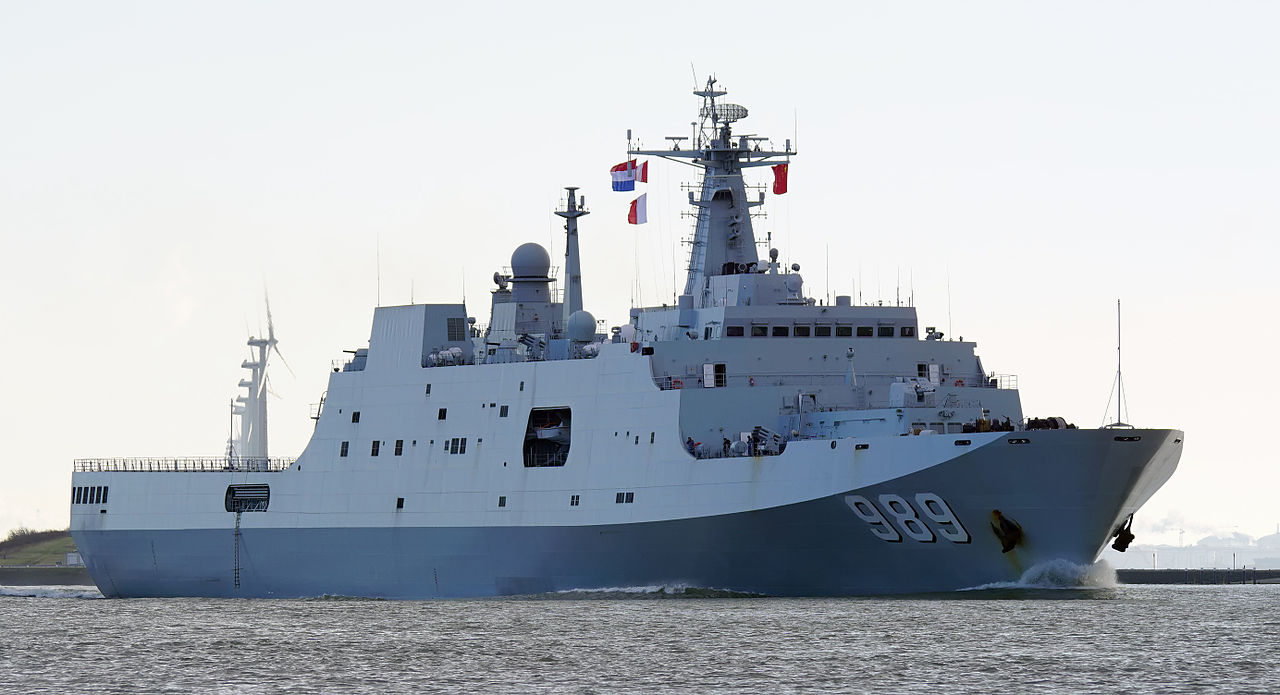
Type 071 Changbaishan
China has long maintained a large amphibious force, primarily with an eye on bringing about reunification with Taiwan. This force, built around a large number of LSTs, was reasonably capable at that mission, but far less effective at projecting power globally. In the last 15 years, the emphasis has shifted, resulting in the 8 strong7 Type 071 LPDs. These each are capable of carrying a battalion of troops (500-600 men) with vehicles, four air-cushioned landing craft in a floodable well deck, and a pair of helicopters. To give more helicopter capability, the PLAN has also developed the Type 075 LHD, which combine a carrier-style flight deck and capacity for around 30 helicopters with a well deck and capacity for a thousand or more troops. Three have been completed, although it's not clear if the full program of 8 ships will be built, or if some will be completed as the more advanced Type 076, which will reportedly have electromagnetic catapults to allow better operation of UAVs. The net result is to give China the capability to deploy a battalion or more of the People's Liberation Army Navy Marine Corps8 virtually anywhere in the world, to provide humanitarian assistance, safeguard its citizens, or just break things. This capability, which the US has made good use of for decades, will be increasingly important as China's involvement overseas grows, particularly through the Belt and Road Initiative.

The best image I could find of a Type 093
One area where China has not invested as heavily is its nuclear submarine force, which numbers only nine attack boats. Three are the antiquated Type 091s, the design of which dates back to the 70s. They appear to be used only for training, freeing the six newer Type 093s, built over the last 15 years, for operational use. These appear to be reasonably capable, although the exact values, particularly for quieting, are a matter of debate. They are expected to be followed by a new class, the Type 095, although when it will enter service and how many will be produced are not clear. Chinese doctrine appears to focus on SSNs as anti-ship platforms, and they have deployed several to the western Indian Ocean, probably as a reminder to India of the potential vulnerability of its sea lanes.
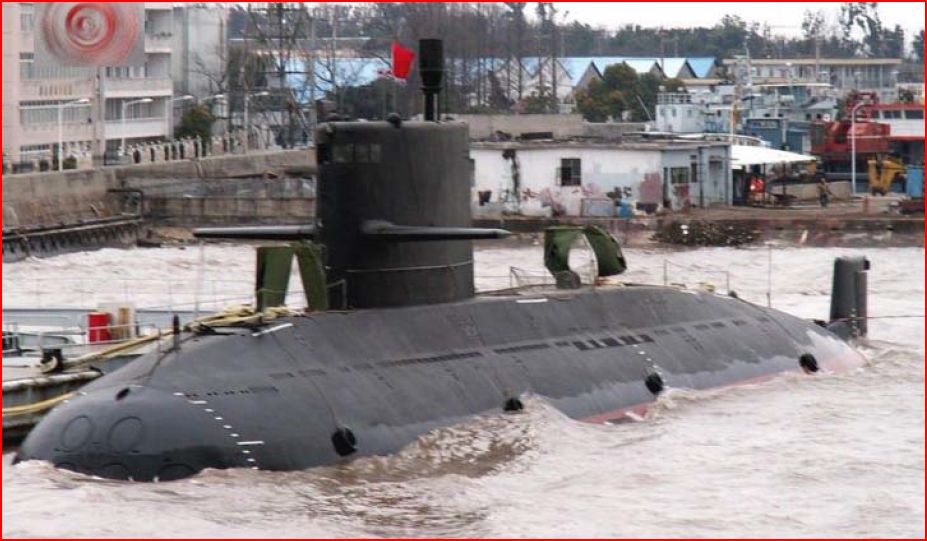
A Type 039A pierside
But the small size of the PLAN's SSN force is partially made up for by its extensive fleet of conventionally-powered submarines. The oldest of these are the obsolescent Type 035s, based on the 1950s Soviet Romeo class. The modern SSK force of three dozen boats is split approximately evenly between the Russian-built Kilo class, the domestic Type 039 and the more modern Type 039A, which have an air-independent propulsion system, and have deployed well into the Indian Ocean.
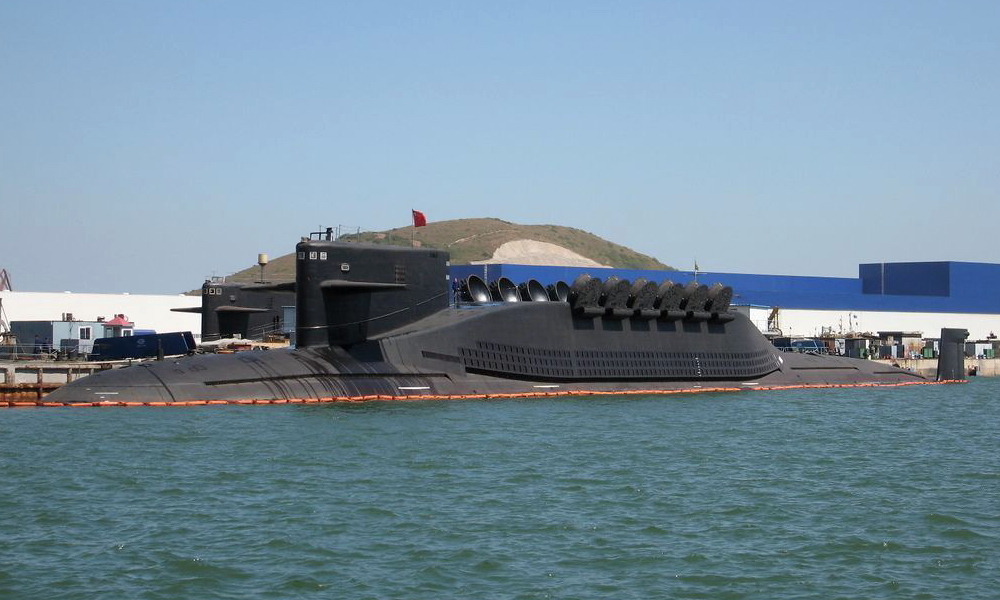
Type 094 SSBN
China also operates a moderately-sized SSBN force, built around six boats of the Type 094 class, each carrying 12 JL-2 SLBMs. Deterrence patrols only began in 2015, and the JL-2 is too short-ranged to reach American targets from patrol areas near the Chinese coast, leading to speculation that the main target to be deterred is India. However, the PLAN is working on another submarine, the Type 096, which will carry the longer-ranged JL-3 missile, fitted with multiple warheads.
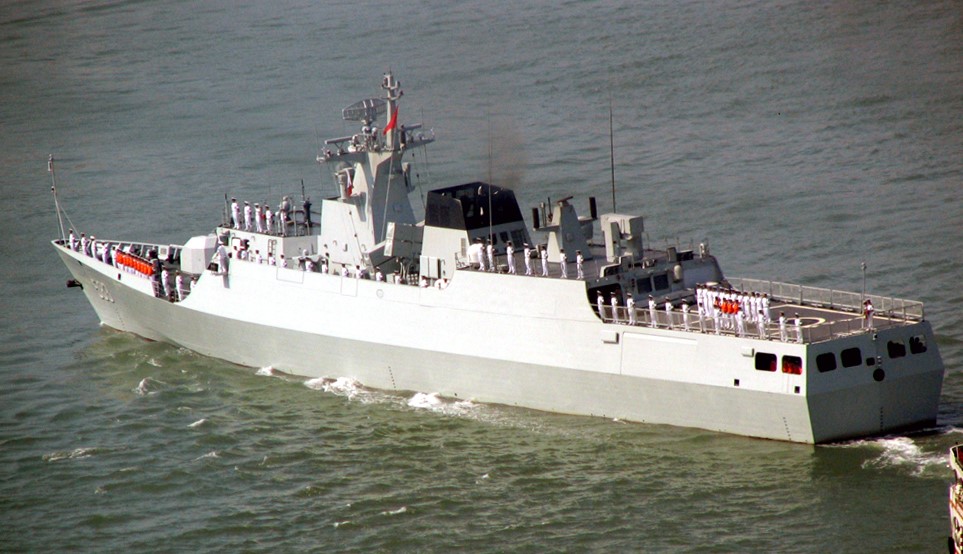
Ganzhou, a Type 056 corvette
But its increasing focus on operations in distant oceans doesn't mean the PLAN has neglected the task of protecting home waters. Of particular concern is keeping the US and allies at bay in the South and East China Seas if war should break out, probably over Taiwan. Some of this work would be done by ships. In particular, the task of hunting submarines would be primarily handled by the Type 056 corvettes, 72 ships equipped with a similar sonar suite to the Type 054A. The Type 056s are also equipped with anti-ship missiles, serving with a number of other small vessels, most notably almost 100 Type 022 catamaran missile boats. These appear to be the last in a long line of Chinese FACs, as their coastal craft going forward will probably be multi-role. The bulk of coastal protection will be done instead by land-based air power and missile forces. The PLAN operates a substantial air force of its own, with 30 bombers and around 280 land-based fighters, as well as auxiliaries. These, when combined with the regular PLAAF, would be tasked with securing the skies over the battle, and delivering missile attacks in combination with the coastal forces and the extensive land-based coastal defense units that make up the last major portion of the PLAN's strength.
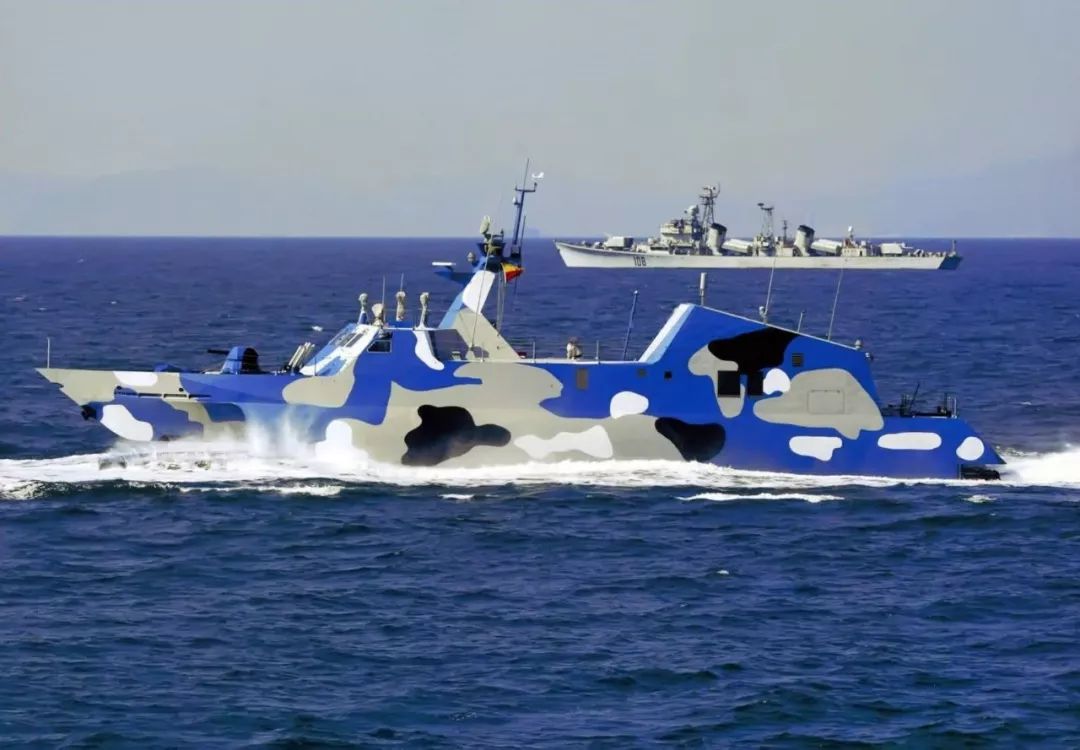
A Type 022 FAC at speed
On the whole, the PLAN is a modern and capable force, one that looks set to not only make China's coastal waters very unpleasant for any attacker, but also to project Chinese power onto the world's oceans. But in many ways, this is a positive sign for global peace. Navies have a great deal of utility beyond their capability in a full-scale hot war, and China is investing heavily in the sort of capabilities that are more useful in peace than war. While the risk of conflict shouldn't be ruled out, the odds are that the world's great navies are in the process of peacefully welcoming a new member to their ranks.
1 It's worth noting that the Chinese are apparently very popular with merchant ships that pass through the area, thanks to their "shoot first, don't bother asking questions" policy with regards to potential pirates. ⇑
2 I am going to use Chinese type numbers instead of NATO reporting names throughout this post. Essentially, this is because Chinese ship types are still mysterious enough that there's a chance to get the proper names in people's heads, instead of the reporting names. ⇑
3 The HQ-16 has slightly more range than ESSM, although it's probably optimized more for aircraft targets instead of missiles. ⇑
5 This is a sonar transducer in a towed body which can be set at any depth the operator desires for better performance. ⇑
6 The Chinese equivalent of the RIM-116 RAM. ⇑
7 A ninth has been ordered by Thailand, and we aren't sure that it's the last one in the program, either. ⇑
8 Yes, that is its name. The PLANMC does operate helicopters, so we can hold out hope for a People's Liberation Army Navy Marine Corps Air Force. ⇑

Comments
Would the equivalent of the Air Commandos be called the People's Liberation Army Navy Marine Corps Air Force Army?
Or is that just silly?
quick correction, liaoning is spelled wrong in the 4th paragraph
Is the Chinese navy being #2 a result of Chinese growth or British rot?
@Daib
Good eyes. Fixed.
@ike
The British slipped to third shortly after WWII when the budget crunch slashed the RN's size. Not sure if they regained second in the 1990s, but China has been growing for the last 15 years. The RN has been reasonably stable over that period.
What are you ranking them by, total displacement?
Eyeballed numbers of major warships (destroyer/frigate and up), because that's what my easiest source has. The RN collapsed hard between 1945 and 1950, while the Soviets had a modest building program.
I would willing to eat my hat if the ex-red fleet turned out to be bigger than the Royal Navy in the 90's.
Maybe a global overview would be useful. I vaguely recall the 8 WWII great powers still having the biggest navies today, but I think my gut feeling are at least 20 years out of date.
Right, the Russian navy was larger than the Chinese one by tonnage up until fairly recently, with much of their tonnage made up of subs. It's worth remembering that the Soviets spent something like three times more on submarines than surface ships, while the Chinese are the inverse.
You don’t want much, do you?
Germany is definitely out of the running, and has been since 1944. The biggest new players who weren’t either one of the 3 Axis powers or holders of a security council seat are India and South Korea, with Australia in 3rd.
If you want more details, then I'd recommend picking up a copy of the Seaforth World Naval Review. They're very good and not that expensive.
The Royal Navy is a shadow of it's former self. They cannot man all of their 19 escort ships, and they have a pitiful number of aircraft on their new aircraft carriers. I would rank the navies like this: 1. USN (USA) 2. PLAN (China) 3. JMSDF (Japan) 4. RN (UK) maybe Russian Navy, could go either way.
Sorry about the quadruple post. I didn't think the post button was working.
It happens, and I don't mind cleaning it up.
Typo: Nitmiz -> Nimitz (at least, that's what I think you meant)
....Would it be fair to say that LIAONING and SHANGDONG are at best CVLs?
These days, that is generally reserved for carriers that only operate STOVL aircraft. They definitely have their limitations, but I'd classify them as full CVs because they have arrestor wires.
@Bean,
That is surprising to hear about Germany. You mention fairly often that they build the best diesel submarines in the world. I guess I sort of assumed they had a navy.
I guess it sort makes sense that would have a large and growing navy. That is a very long boarder that needs defending, and help from the mother-country must be getting harder to come by.
@Bean
A most enjoyable article but I found the last paragraph to be particularly thought provoking and one that I definately hope you will return to in the upcoming years.
The reason it caught my eye is that it reflects thinking I hear emerging (or at least more than just the usual journal and/or symposia/fora/exercise talk) exploring what elements of "beneficial friction" (as I have heard it called) are arising in areas like this.
I know that it is a pretty deep and broad topic, but good to see that you are doing some serious thinking about this. Will be anxious to read more on those occasions when it aligns with your writing.
Germany makes good submarines (or at least used to) but they're kind of a one-trick pony. Given how horribly the F125 program has gone, and their general military readiness, they're not even in the first rank of European navies any more. The latest figures I have put them behind Italy, Turkey and Greece in terms of hulls. In practical terms, probably Spain and the Netherlands, too.
Also, I murdered the second half of my comment by forgetting to type in Australia
You failed to answer the single biggest question about the chinese navy, if Lionang is CV 16, where are CVs 1 through 15?
@jack
you are not wrong about the Royal Navy. All of UK defense really, they just keep cutting, and cutting, and cutting. The UK has 144 fighters in service today. Australia has 143, Singapore has 100, and mighty Spain has 165.
Does anyone actually use 'People's Liberation Forces' instead, or was that an unsuccessful effort to rebrand that didn't work out?
I like the image of the J15 taking off, with the flight deck crew prostrating themselves before the mighty Flanker. Have they copied the US jersey colours? I suppose if it works well enough for the US, then there is no need to change it.
Qiandao Lake, a Type 903
Why would the Chinese use the English version of a Chinese place name for a Chinese naval ship?
Isn't that like the USN having a USS Shen McKinley? Which I suspect would never happen.
@Alexander
I'd guess that it didn't end up happening. I found no trace of it when researching this, and I really should have if it was a thing. As for jerseys, why not copy the USN system? One less thing to work out for yourself.
@Doctorpat
Dealing with other languages is hard and in this case, I copied wikimedia, which chose to translate.
Why do you need that second a?
Should be a space (preferably non-breaking) between the number and the unit.
For some reason, this post has had a lot more typos than usual. The lack of spaces between caliber and unit is unusual, but not wrong.
What was the Bundesmarine's job during the Cold War (or rather in the event of a hot war), keeping the Red Fleet bottled up in the Baltic?
@Alexander: the Shooter was actually a Chinese meme for awhile. And yes, I think they stole the colors from the US; although the US stole them from the Brits anyway.
Update: this link may work better. Everything else about it seems to be paywalled or just not loading anymore for me
@bean searching online doesn't bring up much. I'm sure I heard that somewhere. I guess PLAN is a better acronym anyway, even if it does sound silly when it's spelled out.
@Blackshoe It looks like they are past the Shooter pose, and are now bent over, hands and face pressed to the deck, essentially kowtowing.
In the first photo, I can see a Z-18 on the deck of the Liaoning. Is that a potential domestic built replacement for the Kamovs, for ASW/AEW etc?
@Alexander
I think you heard it from me. I mentioned it in the Carrier Doom series. It was an informal source, although reasonably well-informed, but doesn't seem to have panned out.
@Lambert
Pretty much, AIUI. There was a bit of NATO ASW stuff, too, but they've been left adrift since the end of the Cold War.
Is it just me, or do the chinese designs seem to pack an awful lot into a small hull?
bean:
It is if the unit is metric.
bean:
I just read up on the F125 and what a piece of…excrement (what words are I allowed to use here anyway?). Still, I guess we now know the answer to what do you get when a bunch of pacifists design a warship?
@echo
Not particularly. They're a little bit smaller than their Western equivalents (I'd guess worse habitability was accepted) but it's not like they're doing the traditional export ship thing where they cram a bunch of systems into a tiny hull that can barely stay upright.
@Anonymous
I'm lazy and not going to mess with it. As for the F125, pretty much. Germany's military is a basket case these days.
Now the media are reporting China having more ships than the US.
That's true, if we count all military hulls. But a lot of the Chinese hulls are corvettes and FACs, which is why "all military hulls" is a bad way to count these things.
Are all the FACs etc. based in China, or do they have some in Djibouti or similar? Would they be of any use for presence roles overseas, or do they pretty much have to be tied in to China's coastal defences?
As far as I know, they're all based in China. I wouldn't expect them to be of much use in the presence role, as they're too small and too narrowly focused to be much use there. If they think their base in Djbouti needs defenses, I expect they'd put the missiles on trucks. The big advantage of FACs is mobility, and their base isn't big enough to need that.
Huh? I didn't realize China got a hold of France's old Red Sea colony.
They don't own it. Djbouti decided to capitalize on its strategic position by selling military bases to anyone who will pay. Which is why the US and China both have bases there.
If they aren't strong enough to throw the garrison out, isn't the question of who owns what kind of academic?
"primarily with an eye on bringing about reunification with Taiwan"
why use "reunification with" while "invasion of" would be far better description, AFAIK?
If you have the capacity to invade and crush any resistance, and make it clear that you are willing to do so, that is quite a compelling reason for your 'rogue province' to submit to reunification rather than trying to remain independent. So the plan may not be to bring about an invasion of Taiwan, while still requiring the forces necessary for such an operation.
I find it's better to look at these things at least somewhat within the view of the people involved. It also didn't seem like they were serious about invasion, or they would have built a bigger amphibious force. But this is also a high-level overview and I didn't want to get into the weeds.
bean:
Yet.
Wording clarity: "Shangdong was laid down three years later" is a bit ambiguous between "three years after Liaoning was laid down" and "three years after Liaoning was commissioned." I'm assuming the latter given how long Liaoning was shuffled around?
I'm not seeing the ambiguity there. In context I think it's clear that the antecedent of "later" is the date most recently mentioned in the text, which is 2012. I'm not sure how the paragraph even makes sense if you read it any other way - unless you just assume massive, industrial-scale incompetence on the part of the PLAN, I guess.
Unexpected time machine use during post overhaul: “Only three are in service in early 20212”